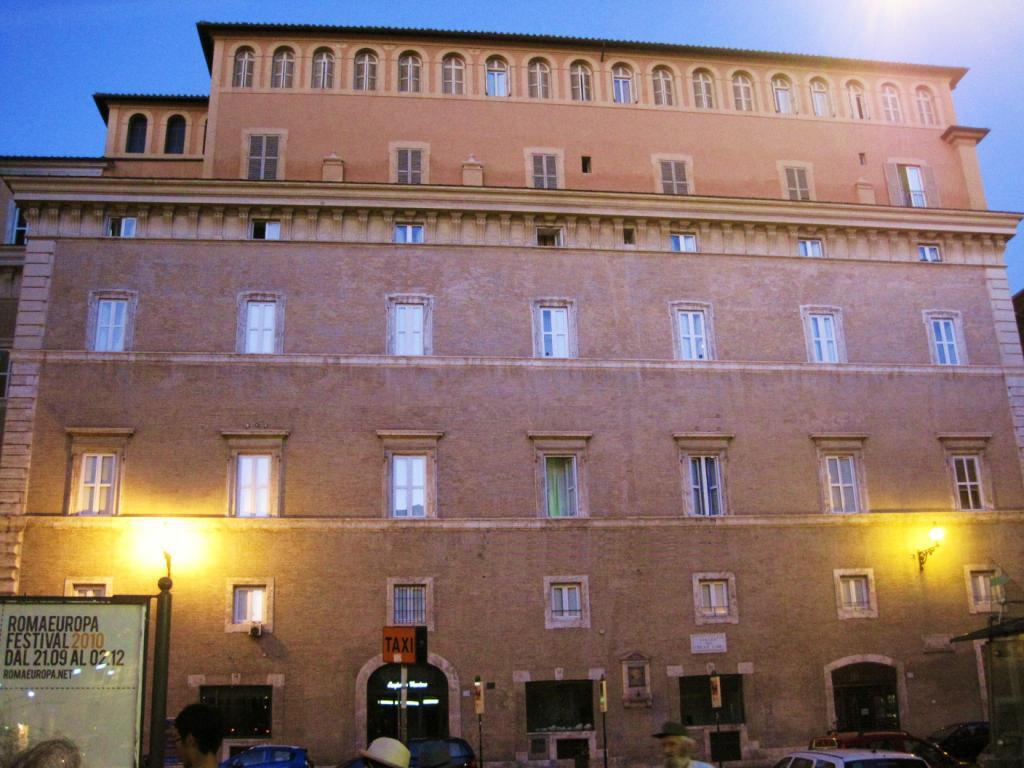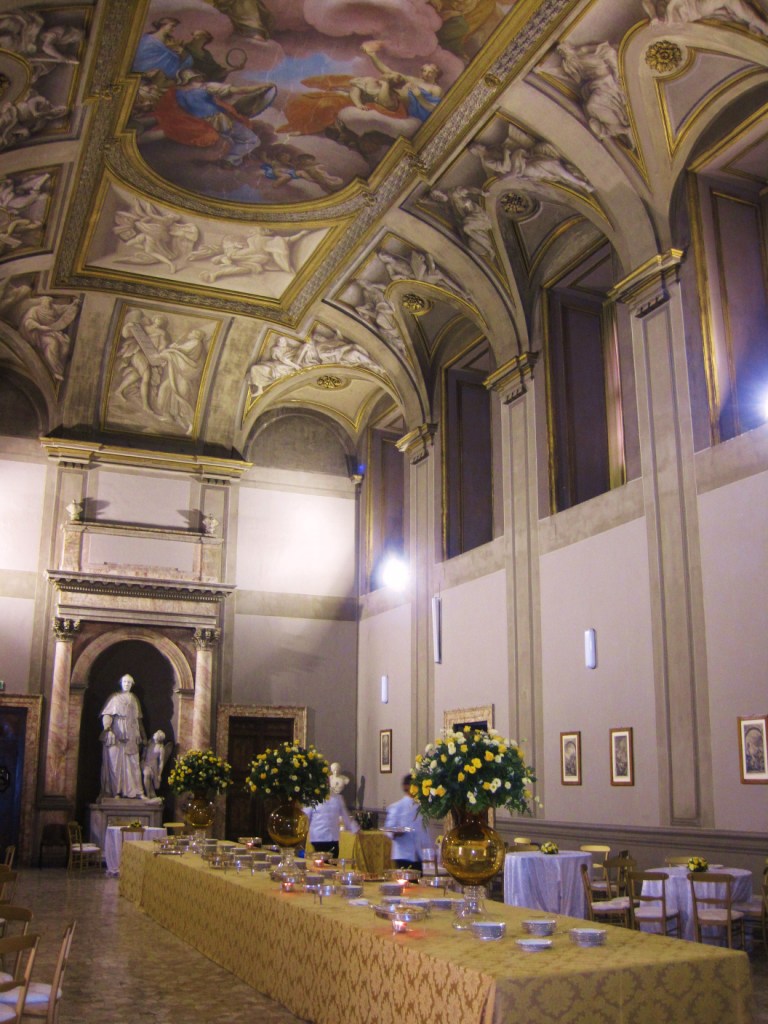Domus Internationalis Paulus VI on:
[Wikipedia]
[Google]
[Amazon]
The Domus Internationalis Paulus VI was established as a Foundation by 
 The original structure of the complex was constructed in the 15th century. In 1573, the palazzo on the site that the present Domus occupies became the seat of the Germanic College, founded by Saint Ignatius of Loyola (1491-1556) and approved by Pope
The original structure of the complex was constructed in the 15th century. In 1573, the palazzo on the site that the present Domus occupies became the seat of the Germanic College, founded by Saint Ignatius of Loyola (1491-1556) and approved by Pope
Pope John Paul II
Pope John Paul II ( la, Ioannes Paulus II; it, Giovanni Paolo II; pl, Jan Paweł II; born Karol Józef Wojtyła ; 18 May 19202 April 2005) was the head of the Catholic Church and sovereign of the Vatican City State from 1978 until his ...
on 6 January 1999. The purpose of the Domus is to accommodate clergy who are assigned to the diplomatic service of the Holy See
The Holy See ( lat, Sancta Sedes, ; it, Santa Sede ), also called the See of Rome, Petrine See or Apostolic See, is the jurisdiction of the Pope in his role as the bishop of Rome. It includes the apostolic episcopal see of the Diocese of Rome ...
, or who are officials of the Roman Curia. The Domus is at the Southern wing of the ''Palazzi di S. Apollinare''. It is an historic Palazzo located in the ancient centre of Rome, and one of the four residences of the Officials of the Roman Curia in Rome; the other three are ''Domus Sanctae Marthae
The Domus Sanctae Marthae (Latin for Saint Martha's House; it, Casa Santa Marta) is a building adjacent to St. Peter's Basilica in Vatican City. Completed in 1996, during the pontificate of Pope John Paul II, it is named after Martha of Bethan ...
'' within the Vatican Walls, the ''Casa San Benedetto'' (the retirement home of Papal Nuncios) at via dell'Erba, and the ''Domus Romana Sacerdotalis'' at via Traspontina. The last two are located near the St. Peter's Square
Saint Peter's Square ( la, Forum Sancti Petri, it, Piazza San Pietro ,) is a large plaza located directly in front of St. Peter's Basilica in Vatican City, the pope, papal enclave and exclave, enclave inside Rome, directly west of the neighbor ...
. Cardinal
Cardinal or The Cardinal may refer to:
Animals
* Cardinal (bird) or Cardinalidae, a family of North and South American birds
**''Cardinalis'', genus of cardinal in the family Cardinalidae
**''Cardinalis cardinalis'', or northern cardinal, the ...
s, bishop
A bishop is an ordained clergy member who is entrusted with a position of authority and oversight in a religious institution.
In Christianity, bishops are normally responsible for the governance of dioceses. The role or office of bishop is ca ...
s and priests
A priest is a religious leader authorized to perform the sacred rituals of a religion, especially as a mediatory agent between humans and one or more deity, deities. They also have the authority or power to administer religious rites; in p ...
who visit the Pope
The pope ( la, papa, from el, πάππας, translit=pappas, 'father'), also known as supreme pontiff ( or ), Roman pontiff () or sovereign pontiff, is the bishop of Rome (or historically the patriarch of Rome), head of the worldwide Cathol ...
in Rome
, established_title = Founded
, established_date = 753 BC
, founder = King Romulus (legendary)
, image_map = Map of comune of Rome (metropolitan city of Capital Rome, region Lazio, Italy).svg
, map_caption ...
or who participate in the various apostolic works of the Holy See also stay at the Domus. The Domus is near the Vatican, notable Roman monuments, and famous sights.

History of the Palazzo
Julius III
Pope Julius III ( la, Iulius PP. III; it, Giulio III; 10 September 1487 – 23 March 1555), born Giovanni Maria Ciocchi del Monte, was head of the Catholic Church and ruler of the Papal States from 7 February 1550 to his death in March 155 ...
in 1552. In 1580, Pope Gregory XIII
Pope Gregory XIII ( la, Gregorius XIII; it, Gregorio XIII; 7 January 1502 – 10 April 1585), born Ugo Boncompagni, was head of the Catholic Church and ruler of the Papal States from 13 May 1572 to his death in April 1585. He is best known for ...
united the college with the Hungarian Institute, which he had founded, thus establishing the Collegium Germanicum et Hungaricum The ''Collegium Germanicum et Hungaricum'', or simply ''Collegium Germanicum'', is a German-speaking seminary for Catholic priests in Rome, founded in 1552. Since 1580 its full name has been ''Pontificium Collegium Germanicum et Hungaricum de Urb'' ...
, which was entrusted to the care of the Jesuits
The Society of Jesus ( la, Societas Iesu; abbreviation: SJ), also known as the Jesuits (; la, Iesuitæ), is a religious order (Catholic), religious order of clerics regular of pontifical right for men in the Catholic Church headquartered in Rom ...
.
In 1634, the original building was demolished and a new edifice was constructed under the direction of the Italian Baroque architect, Paolo Marucelli (1596-1649). The façade of the Palazzo looked on to Via S. Agostino and was joined to the Palazzo Apollinare by an archway above the street.
Following construction on the nearby palazzo of San Luigi dei Francesi, another section of the palazzo was demolished. This allowed for a new design and consequent expansion of the building with the new façade on Via della Scrofa. This was done in 1776 under the direction of the Roman architects Pietro Camporese il Vecchio (1726-1781) and Pasquale Belli (1752-1833). The renovated palazzo was delimited by Via S. Agostino, Via della Scrofa, Via S. Giovanna d'Arco and Piazza delle Cinque Lune. The connecting archway above Via S. Agostino was retained.
In July 1773 the Society of Jesus was suppressed, and the German College was subsequently placed under the care of diocesan clergy until 1789, at which time it was closed and transferred to Ferrara
Ferrara (, ; egl, Fràra ) is a city and ''comune'' in Emilia-Romagna, northern Italy, capital of the Province of Ferrara. it had 132,009 inhabitants. It is situated northeast of Bologna, on the Po di Volano, a branch channel of the main stream ...
(Emilia-Romagna
egl, Emigliàn (man) egl, Emiglièna (woman) rgn, Rumagnòl (man) rgn, Rumagnòla (woman) it, Emiliano (man) it, Emiliana (woman) or it, Romagnolo (man) it, Romagnola (woman)
, population_note =
, population_blank1_title ...
). The Palazzo then became the seat of the Vicariate of Rome.
During the pontificate of Leo XII
Leo or Léo may refer to:
Acronyms
* Law enforcement officer
* Law enforcement organisation
* ''Louisville Eccentric Observer'', a free weekly newspaper in Louisville, Kentucky
* Michigan Department of Labor and Economic Opportunity
Arts an ...
(1823-1829), it became the residence of the Cardinal Vicar
Cardinal Vicar ( it, Cardinale Vicario) is a title commonly given to the vicar general of the Diocese of Rome for the portion of the diocese within Italy (i.e. excluding the portion within Vatican City). The official title, as given in the '' Annu ...
of Rome Placido Zurla
Placido Zurla, O.S.B. Cam., (April 2, 1769 – 29 October 1834) was an Italian Camaldolese monk and prelate, who was Cardinal Vicar of Rome and a writer on medieval geography.
Biography
Zurla was born at Legnago, Veneto, of noble parents and ...
(1769-1834). Cardinal Giuseppe Della Porta Rodiani (1773-1841) also resided at the palazzo as Vicar for Rome from 1838 until his death in 1841.
During the Pontificate of Pius IX
Pope Pius IX ( it, Pio IX, ''Pio Nono''; born Giovanni Maria Mastai Ferretti; 13 May 1792 – 7 February 1878) was head of the Catholic Church from 1846 to 1878, the longest verified papal reign. He was notable for convoking the First Vatican ...
(1846-1878), the building was again enlarged, this time by adding extra floors. The work was carried out under the direction of the architect Antonio Sarti (1797-1880). The newly extended palazzo was destined to become the home of the Seminario Pio, and in this form it remained basically unchanged until 1933, when the façade on the Piazza delle Cinque Lune was demolished and rebuilt along the line of the newly expanded Corso del Rinascimento. This Palazzo became the seat of the Domus Internationalis Paulus VI and the Pontifical Institute of Sacred Music
The Pontifical Institute of Sacred Music ( it, Pontificio istituto di musica sacra; la, Pontificium institutum musicae sacrae) is an institution of higher education of the Roman Catholic Church specifically dedicated to the study of church music ...
.
Domus Internationalis "Paulus VI" and the popes
At least two modern popes used to lodge in the building that is now the Domus Internationalis "Paulus VI" when they werecardinals
Cardinal or The Cardinal may refer to:
Animals
* Cardinal (bird) or Cardinalidae, a family of North and South American birds
**''Cardinalis'', genus of cardinal in the family Cardinalidae
**''Cardinalis cardinalis'', or northern cardinal, the ...
. It was not until 1976 that the Domus Internationalis "Paulus VI", under the name "Casa Internazionale del Clero", was established, but a marker at the entrance to Room 426 indicates it as the one preferred by Angelo Roncalli, the future Pope John XXIII, on his visits to Rome. This is indicated also in the guest list of the entity that occupied the building in the five years when John XXIII was a cardinal (1953-1958). Pope Francis
Pope Francis ( la, Franciscus; it, Francesco; es, link=, Francisco; born Jorge Mario Bergoglio, 17 December 1936) is the head of the Catholic Church. He has been the bishop of Rome and sovereign of the Vatican City State since 13 March 2013. ...
returned in person on the day after his election in order to pay the bill for his stay as Cardinal Jorge Bergoglio before the conclave of March 2013 and to thank the staff.
References
{{coord missing, Italy Buildings and structures completed in 1776 Sites of papal elections Official residences in Vatican City Residential buildings in Vatican City Palaces in Rome Palaces in Vatican City Properties of the Holy See 18th-century architecture in Italy